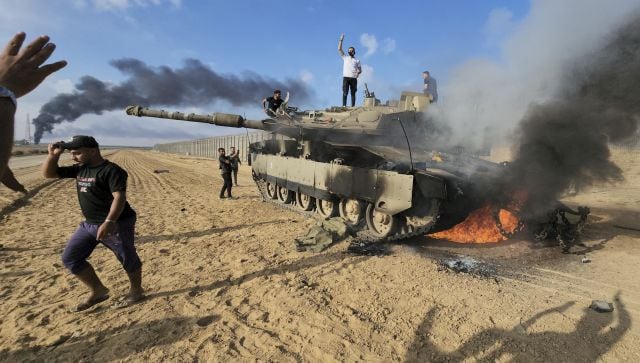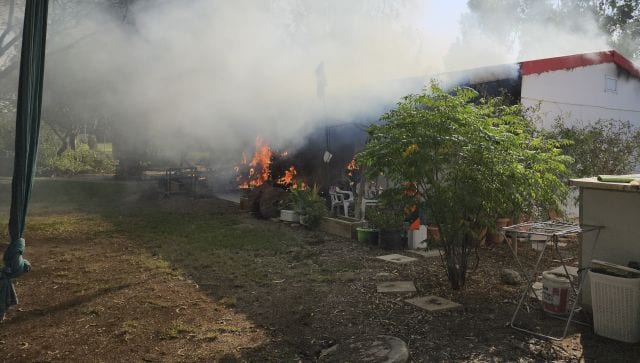As Israel intensifies its attack on Gaza, even journalists are caught in the crosshairs. At least 39 have been killed in the war and now Jerusalem has accused several Gaza-based journalists, who have worked with Western media, of having prior knowledge of that 7 October attack. Israel’s communications minister Shlomo Karhi has accused four international media outlets – The New York Times (NYT), CNN, and news agencies The Associated Press (AP) and Reuters – over the behaviour of four freelance journalists based out of Hamas-controlled Gaza. Shlomo Karhi told the news publications that “individuals within your organisation… had prior knowledge of these horrific actions”. However, NYT, CNN, AP and Reuters have denied the allegations. We take a look at why has Israel made this shocking claim and whether there is any truth to it. What has Israel said? The Israeli minister has accused foreign media of roping in photojournalists who were tipped off on the Hamas attacks . “It has come to our attention that certain individuals within your organization, including photographers and others, had prior knowledge of these horrific actions and may have maintained a troubling connection with the perpetrators,” Karhi wrote on X.
Nitzan Chen, the Israeli government’s press office director, wrote to the bureau chiefs of the four media outlets in Israel asking for clarification regarding the four photographers who filed images of the Hamas attack. The letter accused the photojournalists of arriving at the Israel-Gaza border “alongside Hamas terrorists, documenting the murder of Israeli civilians, lynching of soldiers and kidnappings to Gaza”. It also sought a response to the “disturbing findings” published Wednesday by a pro-Israel non-governmental organisation Honest Reporting, according to a report in Politico.
Benny Gantz, a member of Israel’s War Cabinet, has since said the photojournalists should be treated as terrorists if it is proven they knew in advance of the attacks, reports the BBC. Gantz, a former defence minister and opposition leader who joined the government after the attacks, wrote in a post on X, “Journalists found to have known about the massacre, and [who] still chose to stand as idle bystanders while children were slaughtered, are no different than terrorists and should be treated as such.”
What are the accusations against the photographers? Hamas launched the unprecedented attack on 7 October in southern Israel, killing 1,400 people and abducting 200 others. Images published by the photographers show a burning Israeli tank, Palestinians breaching a fence at the
Kfar Aza kibbutz
, where Hamas terrorists carried out a massacre killing even babies, and other images from the assault. According to Karhi, the photographers were present when the attacks took place “documenting these horrors, effectively becoming participants in this horrifying event”. Honest Reporting in an article headlined “AP & Reuters Pictures of Hamas Atrocities Raise Ethical Questions” said that the “photographers may be part of the plan”. [caption id=“attachment_13372992” align=“alignnone” width=“640”] Palestinians are seen breaking into the Israeli side of the Israel-Gaza border fence after gunmen infiltrated areas of southern Israel on 7 October. This image was taken by photojournalist Mohammed Fayq Abu Mostafa for Reuters.[/caption] Who are the photographers involved? According to Honest Reporting, AP’s photographs from the 7 October attack credit four photographers, Hassan Eslaiah, Yousef Masoud, Ali Mahmud, and Hatem Ali. Eslaiah is a freelance journalist who also works with CNN. He photographed the burning Israeli tank and infiltrators entering Kfar Azza. The journalist also put out tweets on X, which are now deleted, documenting him standing in front of the Israeli tank, claims Honest Reporting. He captioned the post in Arabic, “Live from inside the Gaza Strip settlements.”
Palestinians are seen breaking into the Israeli side of the Israel-Gaza border fence after gunmen infiltrated areas of southern Israel on 7 October. This image was taken by photojournalist Mohammed Fayq Abu Mostafa for Reuters.[/caption] Who are the photographers involved? According to Honest Reporting, AP’s photographs from the 7 October attack credit four photographers, Hassan Eslaiah, Yousef Masoud, Ali Mahmud, and Hatem Ali. Eslaiah is a freelance journalist who also works with CNN. He photographed the burning Israeli tank and infiltrators entering Kfar Azza. The journalist also put out tweets on X, which are now deleted, documenting him standing in front of the Israeli tank, claims Honest Reporting. He captioned the post in Arabic, “Live from inside the Gaza Strip settlements.”
After the article was published, a picture of Eslaiah surfaced with shows Hamas leader Yahya Sinwar kissing him on the cheek. (Firstpost cannot independently verify the authenticity of this image).
The other journalist named by Honest Reporting is Yousef Masoud. His pictures showing Palestinians waving their national flag atop a destroyed Israeli tank were used by AP. He has also worked with NYT in the past, which describes him as “a freelance photographer based in Khan Younis in the Gaza Strip”. The two other photographers named by Honest Reporting, Ali Mahmud and Hatem Ali, took images of Hamas terrorists carrying out the abductions, which were uploaded by AP. The Israeli NGO also named other two photojournalists whose images were used by Reuters, Mohammed Fayq Abu Mostafa and Yasser Qudih. They photographed the burning Israeli tank and Mostafa also took an image of a mob lynching an Israeli soldier. [caption id=“attachment_13373012” align=“alignnone” width=“640”] This picture of Palestinians celebrating by a destroyed Israeli tank at the Gaza Strip fence on 7 October was taken by Gaza-based photographer Hassan Eslaiah. AP and CNN have not cut off ties with him. AP[/caption] What have the media outlets said? The four publications – NYT, AP, Reuters and CNN – have issued statements saying that there were no arrangements in advance with any of the photographers to provide the images. “No AP staff were at the border at the time of the attacks, nor did any AP staffer cross the border at any time,” the agency’s statement said. “When we accept freelance photos, we take great steps to verify the authenticity of the images and that they show what is purported.” AP and CNN have suspended ties with Eslaiah, who is seen in the picture with the Hamas leader. CNN also said that it had no prior knowledge of the Hamas attack. [caption id=“attachment_13373032” align=“alignnone” width=“640”]
This picture of Palestinians celebrating by a destroyed Israeli tank at the Gaza Strip fence on 7 October was taken by Gaza-based photographer Hassan Eslaiah. AP and CNN have not cut off ties with him. AP[/caption] What have the media outlets said? The four publications – NYT, AP, Reuters and CNN – have issued statements saying that there were no arrangements in advance with any of the photographers to provide the images. “No AP staff were at the border at the time of the attacks, nor did any AP staffer cross the border at any time,” the agency’s statement said. “When we accept freelance photos, we take great steps to verify the authenticity of the images and that they show what is purported.” AP and CNN have suspended ties with Eslaiah, who is seen in the picture with the Hamas leader. CNN also said that it had no prior knowledge of the Hamas attack. [caption id=“attachment_13373032” align=“alignnone” width=“640”] A house is on fire in the kibbutz of Kfar Azza, Israel, that Palestinians stormed from the Gaza Strip on 7 October. This image was taken by Hassan Eslaiah. AP[/caption] In response to the article and accusations by Israel, Reuters has “categorically” denied having “prior knowledge of the attack or that we embedded journalists with Hamas on October 7”. “Reuters acquired photographs from two Gaza-based freelance photographers who were at the border on the morning of October 7, with whom it did not have a prior relationship,” the news agency said. “The photographs published by Reuters were taken two hours after Hamas fired rockets across southern Israel and more than 45 minutes after Israel said gunmen had crossed the border. Reuters staff journalists were not on the ground at the locations referred to in the HonestReporting article,” it clarified.
The New York Times
said that accusations of having advanced knowledge or anyone at the publication accompanying Hamas terrorists during the attacks are “untrue and outrageous”. “The advocacy group Honest Reporting has made vague allegations about several freelance photojournalists working in Gaza, including Yousef Masoud. Though Yousef was not working for The Times on the day of the attack, he has since done important work for us,” it said in a statement. “There is no evidence for Honest Reporting’s insinuations. Our review of his work shows that he was doing what photojournalists always do during major news events, documenting the tragedy as it unfolded,” it added. With inputs from agencies
A house is on fire in the kibbutz of Kfar Azza, Israel, that Palestinians stormed from the Gaza Strip on 7 October. This image was taken by Hassan Eslaiah. AP[/caption] In response to the article and accusations by Israel, Reuters has “categorically” denied having “prior knowledge of the attack or that we embedded journalists with Hamas on October 7”. “Reuters acquired photographs from two Gaza-based freelance photographers who were at the border on the morning of October 7, with whom it did not have a prior relationship,” the news agency said. “The photographs published by Reuters were taken two hours after Hamas fired rockets across southern Israel and more than 45 minutes after Israel said gunmen had crossed the border. Reuters staff journalists were not on the ground at the locations referred to in the HonestReporting article,” it clarified.
The New York Times
said that accusations of having advanced knowledge or anyone at the publication accompanying Hamas terrorists during the attacks are “untrue and outrageous”. “The advocacy group Honest Reporting has made vague allegations about several freelance photojournalists working in Gaza, including Yousef Masoud. Though Yousef was not working for The Times on the day of the attack, he has since done important work for us,” it said in a statement. “There is no evidence for Honest Reporting’s insinuations. Our review of his work shows that he was doing what photojournalists always do during major news events, documenting the tragedy as it unfolded,” it added. With inputs from agencies
)